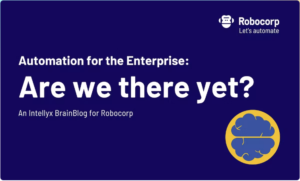For as long as we’ve had cartoons and sci-fi television shows, we’ve seen stories of a friendly robot assistant who could take care of boring household chores and repetitive work tasks.
Fast forward to now, and we have a relatively new but maturing robotic process automation (or RPA) space that is cresting a two-billion dollar market cap, fueled by the success of a handful of major players and many more startups.
However, there’s a problem with gauging the adoption level of RPA using today’s arbitrary market definitions: the much larger adjacent spaces of business process automation and low-code development tools. Businesses have always automated processes through other methods, and software vendors have been trying to reinvent automation for decades now.
What will it take for RPA to deliver sustainable results and reach widespread adoption among global enterprises?
What’s holding back enterprise-grade adoption of RPA?
- Initial investment cost. Per-seat developer tool pricing, per-server/per-node licensing, and complex per-bot and per-run cost scenarios are common in this arena, even when trial offers are extended as a starting incentive.
Surpassing software costs which can at least be predicted, the more initial expense comes from the labor necessary to mine data and design workflows that would create a robust enough piece of automation to augment or replace human work and attention. - Poor reusability / brittle bots. Behind the scenes of a captured screen-based workflow, there is a brittle script – even in a no-code scenario – that is likely very procedural. If different items and data appear on the screen or the steps change in order, the bot breaks. Repairing them requires arcane code commands and configuration methods that can exceed initial setup labor costs.
- Incompatible team skill sets. It’s really hard to find automation tools that fit perfectly into that habitable “goldilocks” skill zone for the team. Non-technical team members can have difficulty managing complex workflows, much less seeing all the decision nodes and data integrations in a no-code environment once it scales in production.
Conversely, developers may be stymied when bots are released or updated unexpectedly and break for unobservable reasons. Dropping in to fix issues is especially frustrating when there is no clear way to interact with code or get detailed feedback from infrastructure elements…




